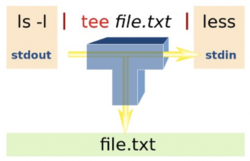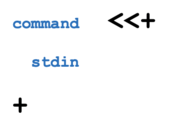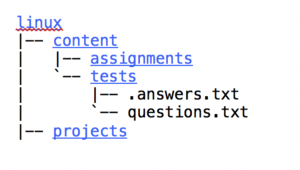Tutorial5: Redirection
Contents
REDIRECTION: STANDARD INPUT / STANDARD OUTPUT / STANDARD ERROR
Main Objectives of this Practice Tutorial
- Understand and use the cut, tr, and wc Linux commands
- Define the terms Standard Input (stdin), Standard Output (stdout), and Standard Error (stderr)
- Understand and use the >, >>, 2>, 2>> symbols with Linux commands
- Understand the purpose of the the /dev/null file and the Here Document
- Define the term pipeline command and explain how a pipeline command functions
- Define the term filter and how it relates to pipeline commands
- Use the semicolon ";" and grouping "( )" symbols to issue multiple Unix / Linux commands on a single line
- Use the backslash "\" symbol to spread-out long Unix/Linux commands over multiple lines
Tutorial Reference Material
| Course Notes |
Linux Command / Shortcut Reference |
YouTube Videos | ||
| Course Notes:
|
Redirection
Multiple Commands |
Redirection Filters | Brauer Instructional Videos: | |
KEY CONCEPTS
Additional File Manipulation Commands
Before proceeding, let's look at some additional commands used to manipulate content of text files.
Refer to the table below regarding these text file manipulation commands:
Redirection (Standard Input, Standard Output, Standard Error)
Redirection can be defined as changing the way from where commands read input to where commands sends output.
You can redirect input and output of a command.
Reference: https://www.javatpoint.com/linux-input-output-redirection
Standard input (stdin) is a term which describes from where a command receives input.
This would apply only to Unix/Linux commands that accept stdin input
(like cat, more, less, sort, grep, head, tail, tr, cut, wc, etc.).
Examples:
tr 'a-z' 'A-Z' < words.txt
cat < abc.txt
sort < xyz.txt
Standard output (stdout) describes where a command sends its output.
In the examples below, output from a command is sent to the monitor, unless it is sent to a text file.
Examples:
ls -l
ls -l > detailed-listing.txt
ls /bin >> output.txt
Standard Error (stderr) describes where a command sends it's error messages. In the examples below we issue the pwd in capitals on purpose to generate an error message, which can be redirected to a text file.
Examples:
PWD
PWD 2> error-message.txt
PWD 2 >> error-messages.txt
PWD 2> /dev/null
The /dev/null File
The /dev/null file (sometimes called the bit bucket or black hole) is a special system file
that discard all data written into it. This is useful to discard unwanted command output.
Examples:
LS 2> /dev/null
ls > /dev/null
find / -name "tempfile" 2> /dev/null
The Here Document
In Linux, the Here Document allows a user to redirect stdin from within the command itself.
Example:
cat <<+
Line 1
Line 2
Line 3
+
Piping (Using Pipes)
Pipeline Command: Having commands send their standard output directly
to standard input of other commands WITHOUT having to use temporary files.
Pipes that are used in a pipeline command are represented by the pipe "|" symbol.
A few simple commands can be combined to form a more powerful command line.
Commands to the right of the pipe symbol are referred to as filters. They are referred to as filters since those commands are used to modify the stdout of the previous command. Many commands can be "piped" together, but these commands (filters) must be chained in a specific order, depending on what you wish to accomplish
Examples:
ls -al | more
ls | sort -r
ls | sort | more
ls -l | cut -d" " -f2 | tr 'a-z' 'A-z"
ls | grep Linux | head -5
head -7 filename | tail -2

(Image licensed under cc)
The tee utility can be used to split the flow of information. The tee option -a can be used to add content to the bottom of an existing file as opposed to overwriting the file's previous contents.
The reason for the name "tee" is that the splitting of the flow of information resembles a capital T.
Examples:
ls | tee unsorted.txt | sort
ls | grep Linux | tee matched.txt | more
ls | head -5 | tee -a listing.txt
Multiple Commands Using Semicolon, Grouping, and Backquotes
Besides piping, there are other ways that multiple commands may be placed in one line:
commands may be separated by semi-colons.
Example:
sleep 5; ls
Multiple commands can also be grouped by using parentheses.
Example:
(echo "Who is on:"; w) > whoson
(Note: all command output is sent to a file)
Commands may also be spread-out over multiple lines, making it easier (for humans) to interpret a long command.
You can add a backslash symbol "\" at the end of a line, to get rid of the special meaning
of newline (to end a command line)
Example:
echo "This will be split over multiple \
lines. Note that the shell will realize \
that a pipe requires another command, so \
it will automatically go to the next line" |tr '[a-z]' '[A-Z]'
INVESTIGATION 1: BASICS OF REDIRECTION
In this section, you will learn how to redirect standard input, standard output and standard error when issuing Unix / Linux commands.
Perform the Following Steps:
- Login to your matrix account and issue a command to confirm you are located in your home directory.
- Issue the following Linux command to create the following directory: mkdir ~/redirect
- Change to the ~/redirect directory and confirm that you changed to that directory.
- Use a text editor to create a file in your current directory called data.txt and enter the following text displayed below:
This is line 1
This is line 2
This is line 3 - Save editing changes and exit the text editor.
- Issue the following Linux command: tr 'a-z' 'A-Z' < data.txt
What does this command do? - Issue the following Linux command: tr 'a-z' 'A-Z' < data.txt > output.txt
What does this command do? What are the contents of the file output.txt? - Issue the following Linux command: tr 'a-z' 'A-Z' > output.txt < data.txt
What does this command do? Is there any difference in terms of this command and the previous command issued? - Issue the following Linux command: tr 'a-z' 'A-Z' >> output.txt < data.txt
What happens to the content of the output.txt file? Why? - Issue the following Linux command: tail -2 < data.txt > output.txt
What does this command do? Check the contents of the output.txt file to confirm. - Issue the following Linux command: tail -2 > output2.txt < data.txt
Why does this command render the same results as the previous command?
Try explaining how the command works in terms of stdin and then stdout. - Issue the following Linux command to create a file: cat > output3.txt
- Enter the follow text displayed below:
This is the file output3.txt - Press ctrl-d to exit the command.
- Issue the cat command to view the contents of the file: output3.txt
- Issue the following Linux command: cp ~murray.saul/uli101/cars .
- Issue the cat command to view the contents of the cars file.
- Issue the following Linux command: cut -c1-10 cars
What did this command do? - Issue the following Linux command: cut -f5 cars > field5.txt
What did this command do? - Issue the following Linux command: cut -f1-3 cars > field123.txt
What did this command do? - Issue the following Linux command: cut -f1,5 cars > field15.txt
What did this command do? - Issue the following Linux command: wc cars > count1.txt
What information does the count1.txt file contain? - Issue the following Linux command: wc cars > count2.txt
What information does the count2.txt file contain? - Issue the following Linux command: ls -l > listing.txt
What information does the count2.txt file contain? - Issue the following Linux command: pwd > listing.txt
What happenned to the original contents of the file called listing.txt? - Issue the following Linux command (use 2 greater-than signs): date >> listing.txt
What information does the listing.txt file contain? - Issue the following Linux command: cat listing.txt cars > combined.txt
What information does the combined.txt file contain?
NOTE: The cat command stands for "concatenate" which means to combine contents of multiple files into a single file. This is why the command is called "cat". - Issue the following Linux command: cat listing.txt cars murray 2> result.txt
What information does the result.txt file contain? - Issue the following Linux command: cat listing.txt cars murray > myoutput.txt 2> result.txt
What is displayed on the monitor? what do those files contain?
The Here Document allows you to redirect stdin from with the Linux command itself. Let's get some practice using the Here Document. - Issue the following Linux command:
cat <<+
line 1
line 2
line 3
+
What do you notice? - Issue the following Linux command:
grep 2 <<+
line 1
line 2
line 3
+
What do you notice? How does this differ from the previous command? Why?
- The problem with using redirection to create files, you have these files taking up space, which requires you remove them. In the next investigation, you will be learning how to issue pipeline commands which can provide information by issuing several Linux commands without creating temporary files.
INVESTIGATION 2: REDIRECTION USING PIPELINE COMMANDS
In this section, you will learn to issue pipeline commands to issue Linux commands without having to generate temporary files.
Perform the Following Steps:
- Confirm that you are still located in the ~/redirect directory.
- Issue the ls command to view the contents of your ~/redirect directory.
The problem with creating temporary files, is that they take up space on your server,
and should be removed. - Issue the following Linux command to remove all temporary files in your redirect directory: rm -r ~/redirect
and confirm that you have removed this directory and its contents.
NOTE: You will be issuing a pipeline command which will use the pipe symbol "|"
that will send the stdout from a command as stdin into another command without having to create temporary files. - Issue the follow Linux pipeline command: ls /bin | more
What happened? - Issue the following Linux pipeline command: ls /bin | who
What happened? Why is the result different than antipated?
NOTE: When issuing pipeline commands, commands to the right of the pipe symbol must be designed to accept standard input. Since the who command does not, you did NOT see the contents of the /bin directory but only information relating to the who command. Therefore, the order of which you build your pipeline command and the type of command that is used as a filter is extremely important! - Issue the following Linux command: ls /bin/?? > listing.txt
- Issue the following Linux command: sort -r listing.txt
- Issue the following Linux command to remove the listing file: rm listing.txt
- Issue the following Linux pipeline command: ls /bin/?? | sort -r
You should notice that the output from this pipeline command is the same output
from the command you issued in step #7 - Issue the following Linux pipeline command: ls /bin/?? | sort -r | more
What is different with this pipeline command as opposed to the previous pipeline command? - Issue the ls command.
You should notice that no files have been created. Let's get practice issuing more pipeline commands
using commands (previously learned or new) to be used as filters. - Issue the following Linux pipeline command: ls /bin/?? | sort -r | head -5
What did you notice? - Issue the following Linux pipeline command: ls /bin/???? | sort -r | grep r | tail -2
What did you notice? - Issue the following Linux pipeline command: ls /bin/???? | sort -r | grep r | cut -c1-3
- Issue the following Linux pipeline command:
ls /bin/???? | tee unsorted.txt | sort -r | tee sorted.txt | tee unmatched.txt | grep r | tail -2
What did you notice? - Check the files that were created to see how the tee command was used in the previous pipeline command.
- Change to your home directory.
- Issue the rm command to only remove the files unsorted.txt , sorted.txt , and unmatched.txt
- In the next investigation, you will learn various techniques to issue multiple Linux commands on the same line, or long Linux commands over multiple lines.
INVESTIGATION 3: ISSUING MULTIPLE UNIX/LINUX COMMANDS
In this section, you will learn how to issue multiple Unix / Linux commands in a single line or over multiple lines.
Perform the Following Steps:
- Issue a Linux command to change to your home directory.
- Confirm you are located in your home directory.
- Issue the following Linux commands (using semicolon to separate each command): cal;pwd;date
Note the from the output the order of how each of those commands were processed. - Issue the following Linux commands: (cal;pwd;date)
Was there any difference in the output of this command as opposed to the previous command?
Let's see how grouping affects working with redirection. - Issue the following Linux commands: cal;pwd;date > output.txt
- Issue a Linux command to view the contents of the file called output.txt
What do you notice?
Let's use grouping to make modification to the previous command - Issue the following Linux commands: (cal;pwd;date) > output.txt
- Issue a Linux command to view the contents of the file called output.txt
What do you notice? What did grouping the three Linux commands do? - Issue the following Linux pipeline command (using \ at the end of most lines):
echo "This will be split over multiple \
lines. Note that the shell will realize \
that a pipe requires another command, so \
it will automatically go to the next line" |tr '[a-z]' '[A-Z]'
Did the command work? What does this command do? - After you complete the Review Questions sections to get additional practice, then work on your online assignment 2
and complete section3 labelled: Redirection and Pipes.
LINUX PRACTICE QUESTIONS
The purpose of this section is to obtain extra practice to help with quizzes, your midterm, and your final exam.
Here is a link to the MS Word Document of ALL of the questions displayed below but with extra room to answer on the document to simulate a quiz:
https://ict.senecacollege.ca/~murray.saul/uli101/uli101_week5_practice.docx
Your instructor may take-up these questions during class. It is up to the student to attend classes in order to obtain the answers to the following questions. Your instructor will NOT provide these answers in any other form (eg. e-mail, etc).
When answering Linux command questions, refer to the following Inverted Tree Diagram. The linux directory is contained in your home directory. Assume that you just logged into your Matrix account. Directories are underlined.
Review Questions:
- Write a single Linux command to provide a detailed listing of all files in the /bin directory, sending the output to a file called listing.txt in the “projects” directory (append output to existing file and use a relative pathname)
- Write a single Linux command to redirect the stderr from the command:
cat a.txt b.txt c.txt to a file called error.txt contained in the “assignments” directory. (overwrite previous file’s contents and use only relative pathnames) - Write a single Linux command: cat ~/a.txt ~/b.txt ~/c.txt and redirect stdout to a file called “good.txt” to the “tests” directory and stderr to a file called “bad.txt” to the “tests” directory. (overwrite previous contents for both files and use only relative-to-home pathnames).
- Write a single Linux command to redirect the stdout from the command:
cat a.txt b.txt c.txt to a file called wrong.txt contained in the “projects” directory and throw-out any standard error messages so they don’t appear on the screen (append output to existing file and use only relative pathnames). - Write a single Linux pipeline command to display a detailed listing of the projects directory but pause one screen at a time to view and navigate through all of the directory contents. Use a relative-to-home pathname.
- Write a single Linux pipeline command to display the sorted contents (in reverse alphabetical order) of the “linux” directory. Use a relative pathname.
- Assume that the text file called “.answers.txt” contains 10 lines. Write a single Linux pipeline command to only displays lines 5 through 8 for this file. Use only relative pathnames.
- Write a single Linux pipeline command to only display the contents of the “assignments” directory whose filenames match the pattern “murray” (both upper or lowercase). Use an absolute pathname.
- Write a single Linux pipeline command to display the number of characters contained in the file called “.answers.txt”. Use a relative-to-home pathname.
- Write a single Linux pipeline command to display the number of lines contained in the file called “questions.txt”. Use a relative pathname.
- Write a single Linux pipeline command to display only the first 10 characters of each filename contained in your current directory. Also, there is will be a lot of output, so also pause at each screenful so you can navigate throughout the display contents. Use a relative pathname.
- Create a table listing each Linux command, useful options that were mentioned in this tutorial for the following Linux commands: cut , tr , wc , and tee.









